An Analysis of Employee Motivation and Productivity in Banking
VerifiedAdded on 2020/05/28
|13
|2944
|119
Report
AI Summary
This report examines the critical relationship between employee motivation and productivity within the banking sector. It begins with a review of secondary sources, exploring post-selection HRM practices, their impact on organizational performance, and the role of employee motivation. The report delves into various motivational theories, particularly Maslow's hierarchy, and explores how monetary and non-monetary rewards are used to enhance employee engagement. It analyzes the relationship between employee motivation and productivity, highlighting motivational strategies such as incentives, recognition, and trust-building. The report also outlines techniques used to motivate employees, including addressing individual needs, setting motivational tools, applying motivators, and gathering feedback. The study employs a mixed-method approach, using both primary and secondary data to identify factors that influence employee motivation and their effects on performance, with the aim of recommending effective motivational techniques.
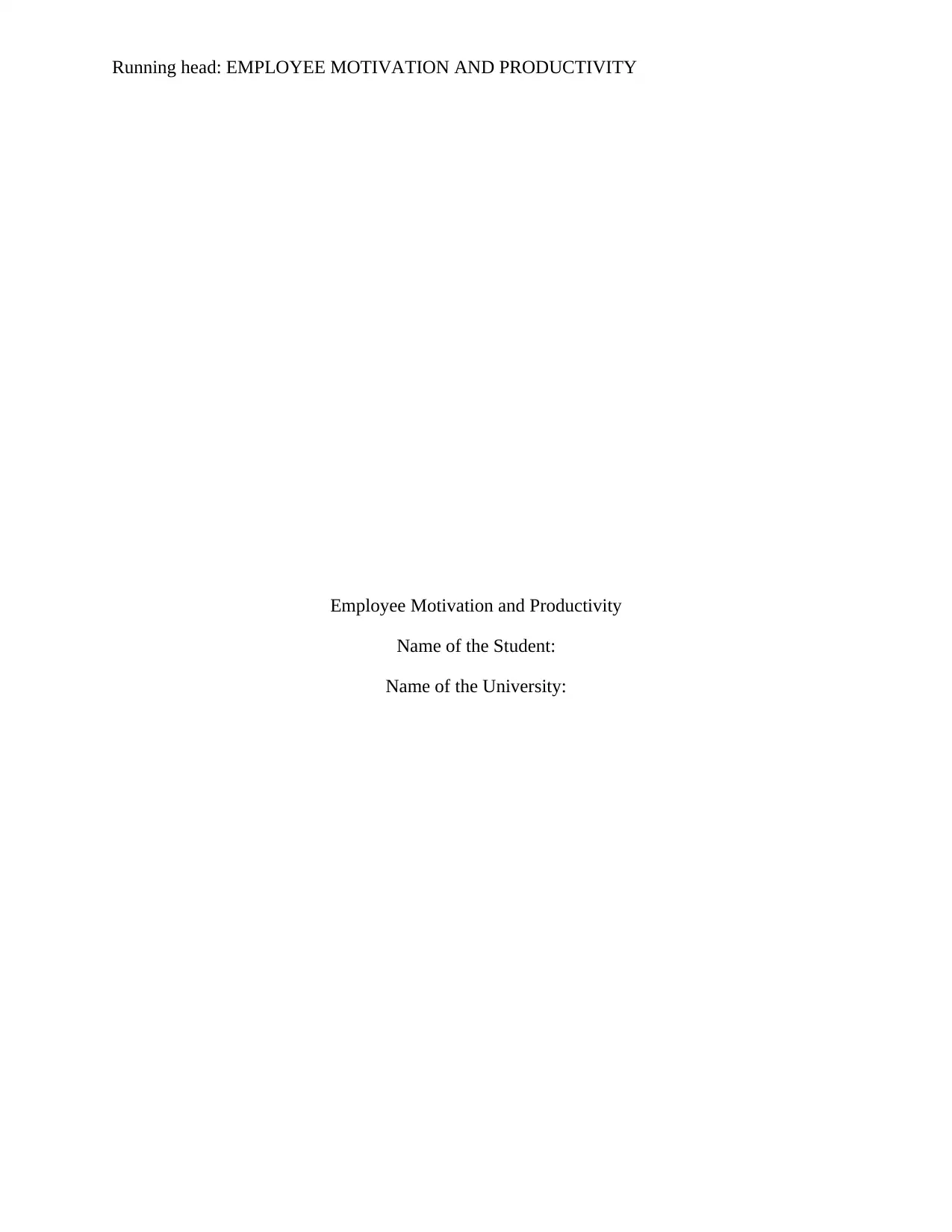
Running head: EMPLOYEE MOTIVATION AND PRODUCTIVITY
Employee Motivation and Productivity
Name of the Student:
Name of the University:
Employee Motivation and Productivity
Name of the Student:
Name of the University:
Paraphrase This Document
Need a fresh take? Get an instant paraphrase of this document with our AI Paraphraser
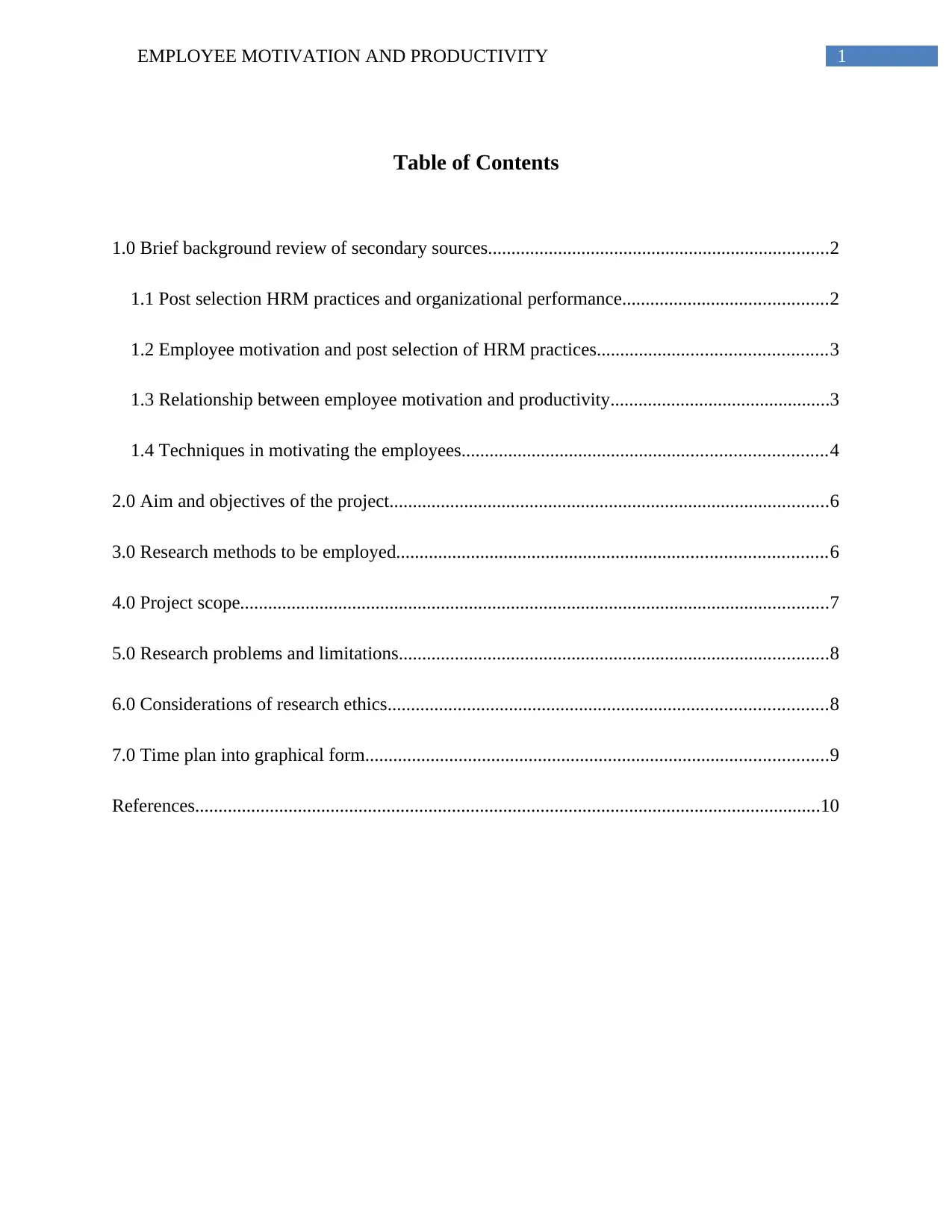
1EMPLOYEE MOTIVATION AND PRODUCTIVITY
Table of Contents
1.0 Brief background review of secondary sources.........................................................................2
1.1 Post selection HRM practices and organizational performance............................................2
1.2 Employee motivation and post selection of HRM practices.................................................3
1.3 Relationship between employee motivation and productivity...............................................3
1.4 Techniques in motivating the employees..............................................................................4
2.0 Aim and objectives of the project..............................................................................................6
3.0 Research methods to be employed............................................................................................6
4.0 Project scope..............................................................................................................................7
5.0 Research problems and limitations............................................................................................8
6.0 Considerations of research ethics..............................................................................................8
7.0 Time plan into graphical form...................................................................................................9
References......................................................................................................................................10
Table of Contents
1.0 Brief background review of secondary sources.........................................................................2
1.1 Post selection HRM practices and organizational performance............................................2
1.2 Employee motivation and post selection of HRM practices.................................................3
1.3 Relationship between employee motivation and productivity...............................................3
1.4 Techniques in motivating the employees..............................................................................4
2.0 Aim and objectives of the project..............................................................................................6
3.0 Research methods to be employed............................................................................................6
4.0 Project scope..............................................................................................................................7
5.0 Research problems and limitations............................................................................................8
6.0 Considerations of research ethics..............................................................................................8
7.0 Time plan into graphical form...................................................................................................9
References......................................................................................................................................10
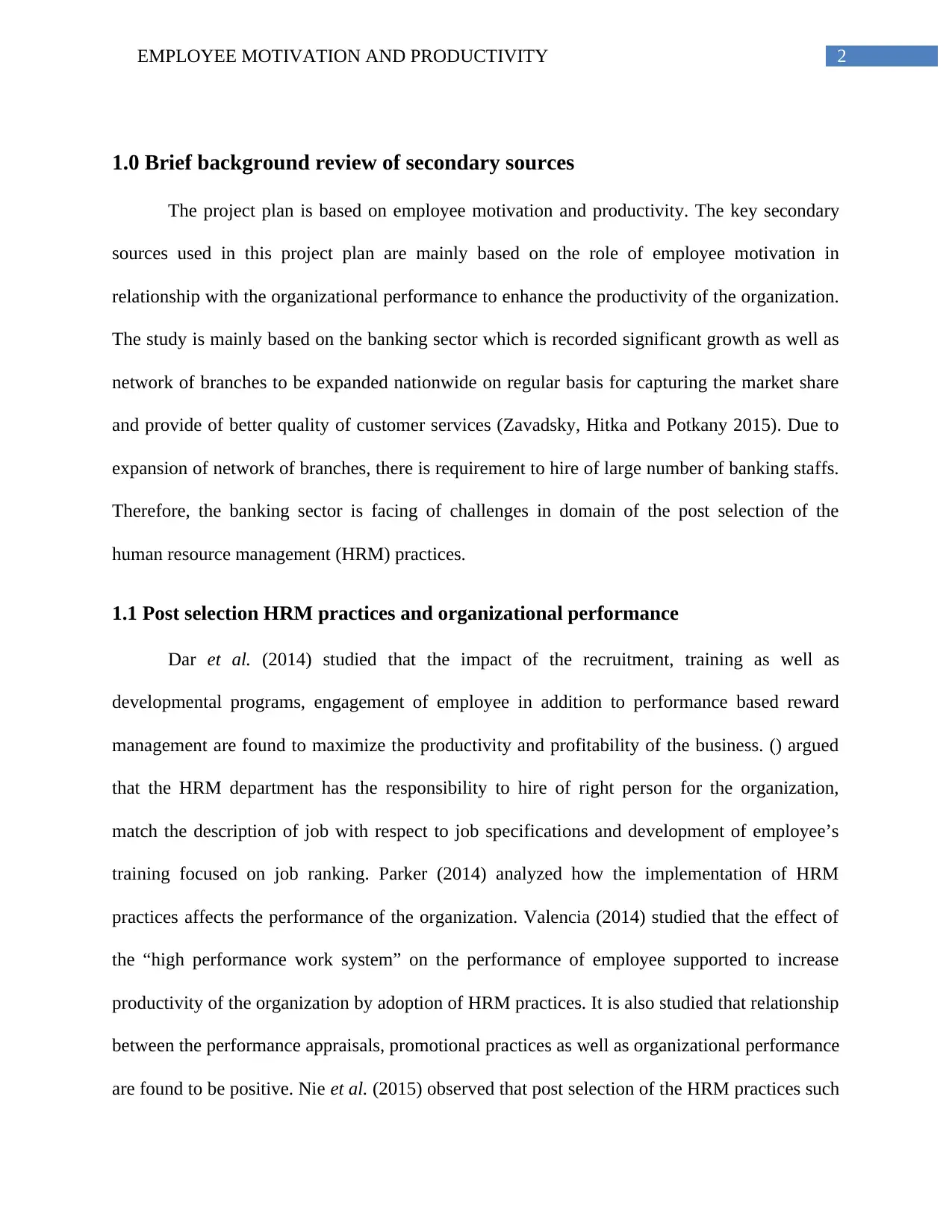
2EMPLOYEE MOTIVATION AND PRODUCTIVITY
1.0 Brief background review of secondary sources
The project plan is based on employee motivation and productivity. The key secondary
sources used in this project plan are mainly based on the role of employee motivation in
relationship with the organizational performance to enhance the productivity of the organization.
The study is mainly based on the banking sector which is recorded significant growth as well as
network of branches to be expanded nationwide on regular basis for capturing the market share
and provide of better quality of customer services (Zavadsky, Hitka and Potkany 2015). Due to
expansion of network of branches, there is requirement to hire of large number of banking staffs.
Therefore, the banking sector is facing of challenges in domain of the post selection of the
human resource management (HRM) practices.
1.1 Post selection HRM practices and organizational performance
Dar et al. (2014) studied that the impact of the recruitment, training as well as
developmental programs, engagement of employee in addition to performance based reward
management are found to maximize the productivity and profitability of the business. () argued
that the HRM department has the responsibility to hire of right person for the organization,
match the description of job with respect to job specifications and development of employee’s
training focused on job ranking. Parker (2014) analyzed how the implementation of HRM
practices affects the performance of the organization. Valencia (2014) studied that the effect of
the “high performance work system” on the performance of employee supported to increase
productivity of the organization by adoption of HRM practices. It is also studied that relationship
between the performance appraisals, promotional practices as well as organizational performance
are found to be positive. Nie et al. (2015) observed that post selection of the HRM practices such
1.0 Brief background review of secondary sources
The project plan is based on employee motivation and productivity. The key secondary
sources used in this project plan are mainly based on the role of employee motivation in
relationship with the organizational performance to enhance the productivity of the organization.
The study is mainly based on the banking sector which is recorded significant growth as well as
network of branches to be expanded nationwide on regular basis for capturing the market share
and provide of better quality of customer services (Zavadsky, Hitka and Potkany 2015). Due to
expansion of network of branches, there is requirement to hire of large number of banking staffs.
Therefore, the banking sector is facing of challenges in domain of the post selection of the
human resource management (HRM) practices.
1.1 Post selection HRM practices and organizational performance
Dar et al. (2014) studied that the impact of the recruitment, training as well as
developmental programs, engagement of employee in addition to performance based reward
management are found to maximize the productivity and profitability of the business. () argued
that the HRM department has the responsibility to hire of right person for the organization,
match the description of job with respect to job specifications and development of employee’s
training focused on job ranking. Parker (2014) analyzed how the implementation of HRM
practices affects the performance of the organization. Valencia (2014) studied that the effect of
the “high performance work system” on the performance of employee supported to increase
productivity of the organization by adoption of HRM practices. It is also studied that relationship
between the performance appraisals, promotional practices as well as organizational performance
are found to be positive. Nie et al. (2015) observed that post selection of the HRM practices such
⊘ This is a preview!⊘
Do you want full access?
Subscribe today to unlock all pages.

Trusted by 1+ million students worldwide
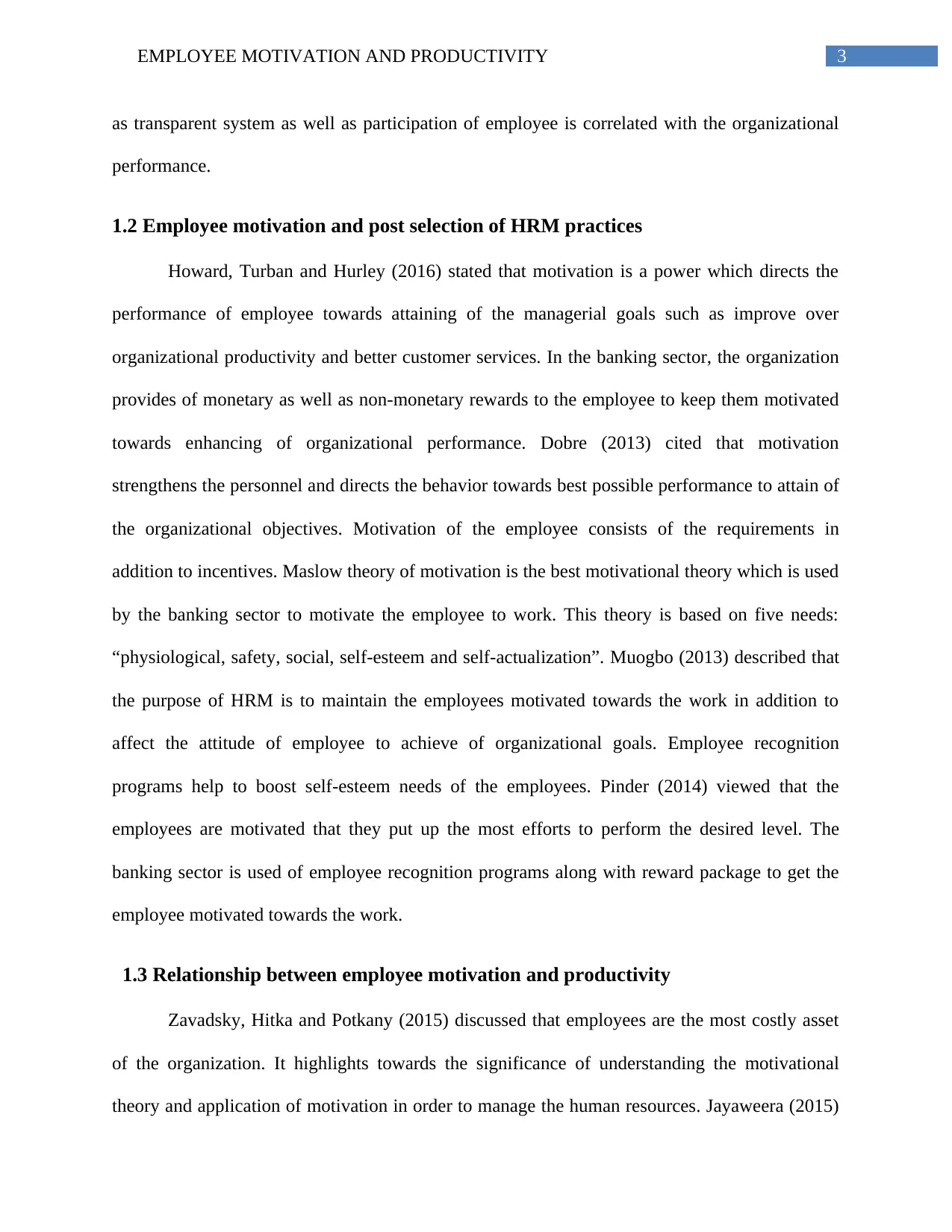
3EMPLOYEE MOTIVATION AND PRODUCTIVITY
as transparent system as well as participation of employee is correlated with the organizational
performance.
1.2 Employee motivation and post selection of HRM practices
Howard, Turban and Hurley (2016) stated that motivation is a power which directs the
performance of employee towards attaining of the managerial goals such as improve over
organizational productivity and better customer services. In the banking sector, the organization
provides of monetary as well as non-monetary rewards to the employee to keep them motivated
towards enhancing of organizational performance. Dobre (2013) cited that motivation
strengthens the personnel and directs the behavior towards best possible performance to attain of
the organizational objectives. Motivation of the employee consists of the requirements in
addition to incentives. Maslow theory of motivation is the best motivational theory which is used
by the banking sector to motivate the employee to work. This theory is based on five needs:
“physiological, safety, social, self-esteem and self-actualization”. Muogbo (2013) described that
the purpose of HRM is to maintain the employees motivated towards the work in addition to
affect the attitude of employee to achieve of organizational goals. Employee recognition
programs help to boost self-esteem needs of the employees. Pinder (2014) viewed that the
employees are motivated that they put up the most efforts to perform the desired level. The
banking sector is used of employee recognition programs along with reward package to get the
employee motivated towards the work.
1.3 Relationship between employee motivation and productivity
Zavadsky, Hitka and Potkany (2015) discussed that employees are the most costly asset
of the organization. It highlights towards the significance of understanding the motivational
theory and application of motivation in order to manage the human resources. Jayaweera (2015)
as transparent system as well as participation of employee is correlated with the organizational
performance.
1.2 Employee motivation and post selection of HRM practices
Howard, Turban and Hurley (2016) stated that motivation is a power which directs the
performance of employee towards attaining of the managerial goals such as improve over
organizational productivity and better customer services. In the banking sector, the organization
provides of monetary as well as non-monetary rewards to the employee to keep them motivated
towards enhancing of organizational performance. Dobre (2013) cited that motivation
strengthens the personnel and directs the behavior towards best possible performance to attain of
the organizational objectives. Motivation of the employee consists of the requirements in
addition to incentives. Maslow theory of motivation is the best motivational theory which is used
by the banking sector to motivate the employee to work. This theory is based on five needs:
“physiological, safety, social, self-esteem and self-actualization”. Muogbo (2013) described that
the purpose of HRM is to maintain the employees motivated towards the work in addition to
affect the attitude of employee to achieve of organizational goals. Employee recognition
programs help to boost self-esteem needs of the employees. Pinder (2014) viewed that the
employees are motivated that they put up the most efforts to perform the desired level. The
banking sector is used of employee recognition programs along with reward package to get the
employee motivated towards the work.
1.3 Relationship between employee motivation and productivity
Zavadsky, Hitka and Potkany (2015) discussed that employees are the most costly asset
of the organization. It highlights towards the significance of understanding the motivational
theory and application of motivation in order to manage the human resources. Jayaweera (2015)
Paraphrase This Document
Need a fresh take? Get an instant paraphrase of this document with our AI Paraphraser
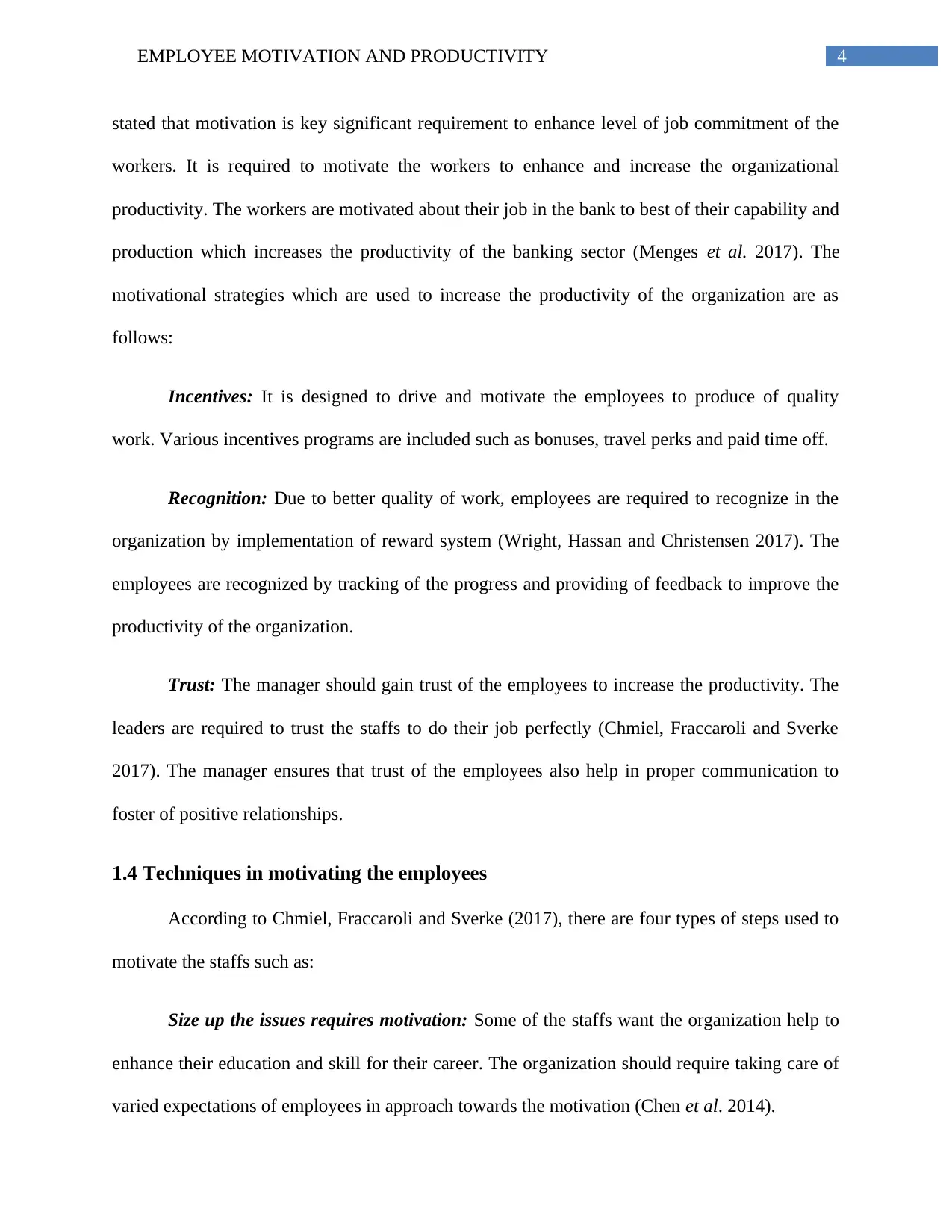
4EMPLOYEE MOTIVATION AND PRODUCTIVITY
stated that motivation is key significant requirement to enhance level of job commitment of the
workers. It is required to motivate the workers to enhance and increase the organizational
productivity. The workers are motivated about their job in the bank to best of their capability and
production which increases the productivity of the banking sector (Menges et al. 2017). The
motivational strategies which are used to increase the productivity of the organization are as
follows:
Incentives: It is designed to drive and motivate the employees to produce of quality
work. Various incentives programs are included such as bonuses, travel perks and paid time off.
Recognition: Due to better quality of work, employees are required to recognize in the
organization by implementation of reward system (Wright, Hassan and Christensen 2017). The
employees are recognized by tracking of the progress and providing of feedback to improve the
productivity of the organization.
Trust: The manager should gain trust of the employees to increase the productivity. The
leaders are required to trust the staffs to do their job perfectly (Chmiel, Fraccaroli and Sverke
2017). The manager ensures that trust of the employees also help in proper communication to
foster of positive relationships.
1.4 Techniques in motivating the employees
According to Chmiel, Fraccaroli and Sverke (2017), there are four types of steps used to
motivate the staffs such as:
Size up the issues requires motivation: Some of the staffs want the organization help to
enhance their education and skill for their career. The organization should require taking care of
varied expectations of employees in approach towards the motivation (Chen et al. 2014).
stated that motivation is key significant requirement to enhance level of job commitment of the
workers. It is required to motivate the workers to enhance and increase the organizational
productivity. The workers are motivated about their job in the bank to best of their capability and
production which increases the productivity of the banking sector (Menges et al. 2017). The
motivational strategies which are used to increase the productivity of the organization are as
follows:
Incentives: It is designed to drive and motivate the employees to produce of quality
work. Various incentives programs are included such as bonuses, travel perks and paid time off.
Recognition: Due to better quality of work, employees are required to recognize in the
organization by implementation of reward system (Wright, Hassan and Christensen 2017). The
employees are recognized by tracking of the progress and providing of feedback to improve the
productivity of the organization.
Trust: The manager should gain trust of the employees to increase the productivity. The
leaders are required to trust the staffs to do their job perfectly (Chmiel, Fraccaroli and Sverke
2017). The manager ensures that trust of the employees also help in proper communication to
foster of positive relationships.
1.4 Techniques in motivating the employees
According to Chmiel, Fraccaroli and Sverke (2017), there are four types of steps used to
motivate the staffs such as:
Size up the issues requires motivation: Some of the staffs want the organization help to
enhance their education and skill for their career. The organization should require taking care of
varied expectations of employees in approach towards the motivation (Chen et al. 2014).
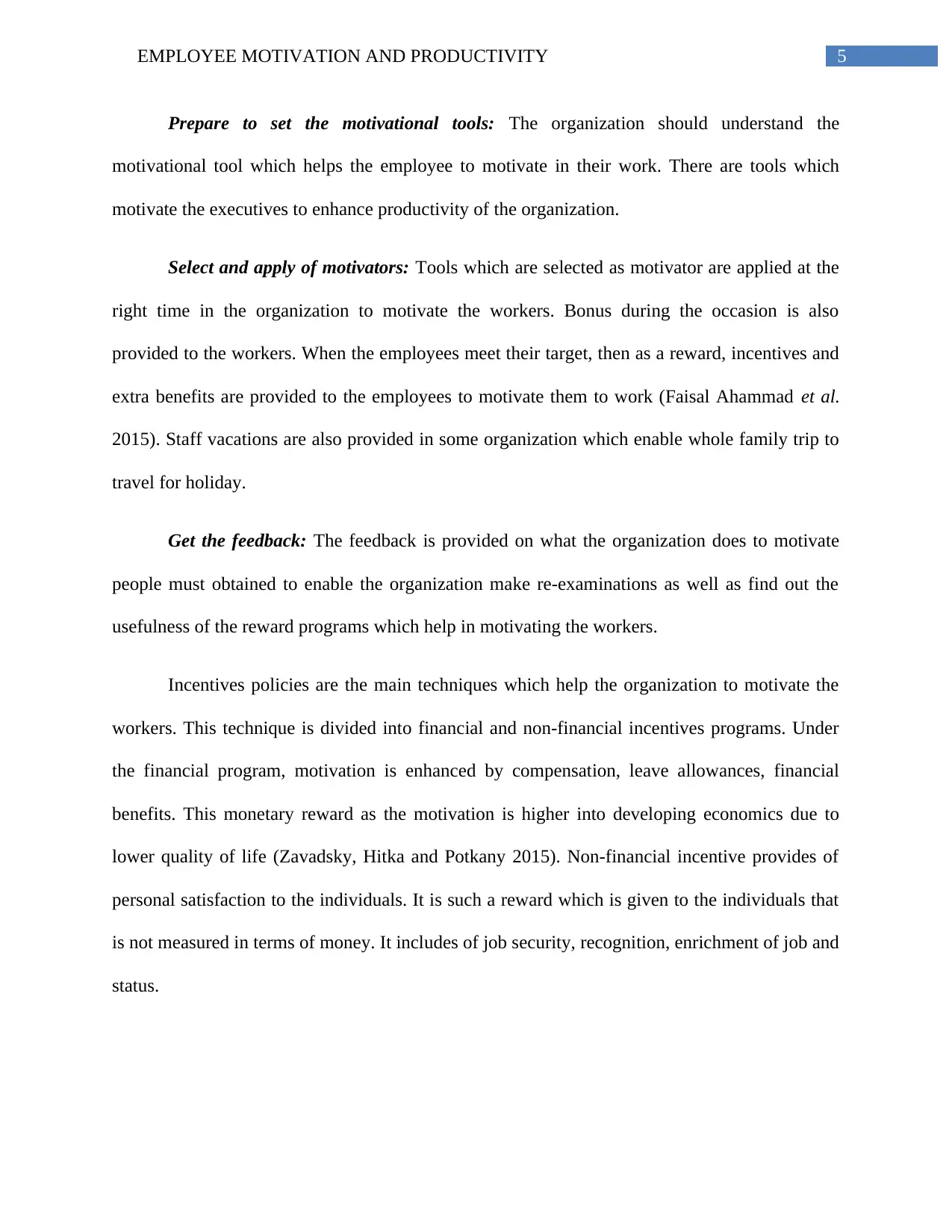
5EMPLOYEE MOTIVATION AND PRODUCTIVITY
Prepare to set the motivational tools: The organization should understand the
motivational tool which helps the employee to motivate in their work. There are tools which
motivate the executives to enhance productivity of the organization.
Select and apply of motivators: Tools which are selected as motivator are applied at the
right time in the organization to motivate the workers. Bonus during the occasion is also
provided to the workers. When the employees meet their target, then as a reward, incentives and
extra benefits are provided to the employees to motivate them to work (Faisal Ahammad et al.
2015). Staff vacations are also provided in some organization which enable whole family trip to
travel for holiday.
Get the feedback: The feedback is provided on what the organization does to motivate
people must obtained to enable the organization make re-examinations as well as find out the
usefulness of the reward programs which help in motivating the workers.
Incentives policies are the main techniques which help the organization to motivate the
workers. This technique is divided into financial and non-financial incentives programs. Under
the financial program, motivation is enhanced by compensation, leave allowances, financial
benefits. This monetary reward as the motivation is higher into developing economics due to
lower quality of life (Zavadsky, Hitka and Potkany 2015). Non-financial incentive provides of
personal satisfaction to the individuals. It is such a reward which is given to the individuals that
is not measured in terms of money. It includes of job security, recognition, enrichment of job and
status.
Prepare to set the motivational tools: The organization should understand the
motivational tool which helps the employee to motivate in their work. There are tools which
motivate the executives to enhance productivity of the organization.
Select and apply of motivators: Tools which are selected as motivator are applied at the
right time in the organization to motivate the workers. Bonus during the occasion is also
provided to the workers. When the employees meet their target, then as a reward, incentives and
extra benefits are provided to the employees to motivate them to work (Faisal Ahammad et al.
2015). Staff vacations are also provided in some organization which enable whole family trip to
travel for holiday.
Get the feedback: The feedback is provided on what the organization does to motivate
people must obtained to enable the organization make re-examinations as well as find out the
usefulness of the reward programs which help in motivating the workers.
Incentives policies are the main techniques which help the organization to motivate the
workers. This technique is divided into financial and non-financial incentives programs. Under
the financial program, motivation is enhanced by compensation, leave allowances, financial
benefits. This monetary reward as the motivation is higher into developing economics due to
lower quality of life (Zavadsky, Hitka and Potkany 2015). Non-financial incentive provides of
personal satisfaction to the individuals. It is such a reward which is given to the individuals that
is not measured in terms of money. It includes of job security, recognition, enrichment of job and
status.
⊘ This is a preview!⊘
Do you want full access?
Subscribe today to unlock all pages.

Trusted by 1+ million students worldwide
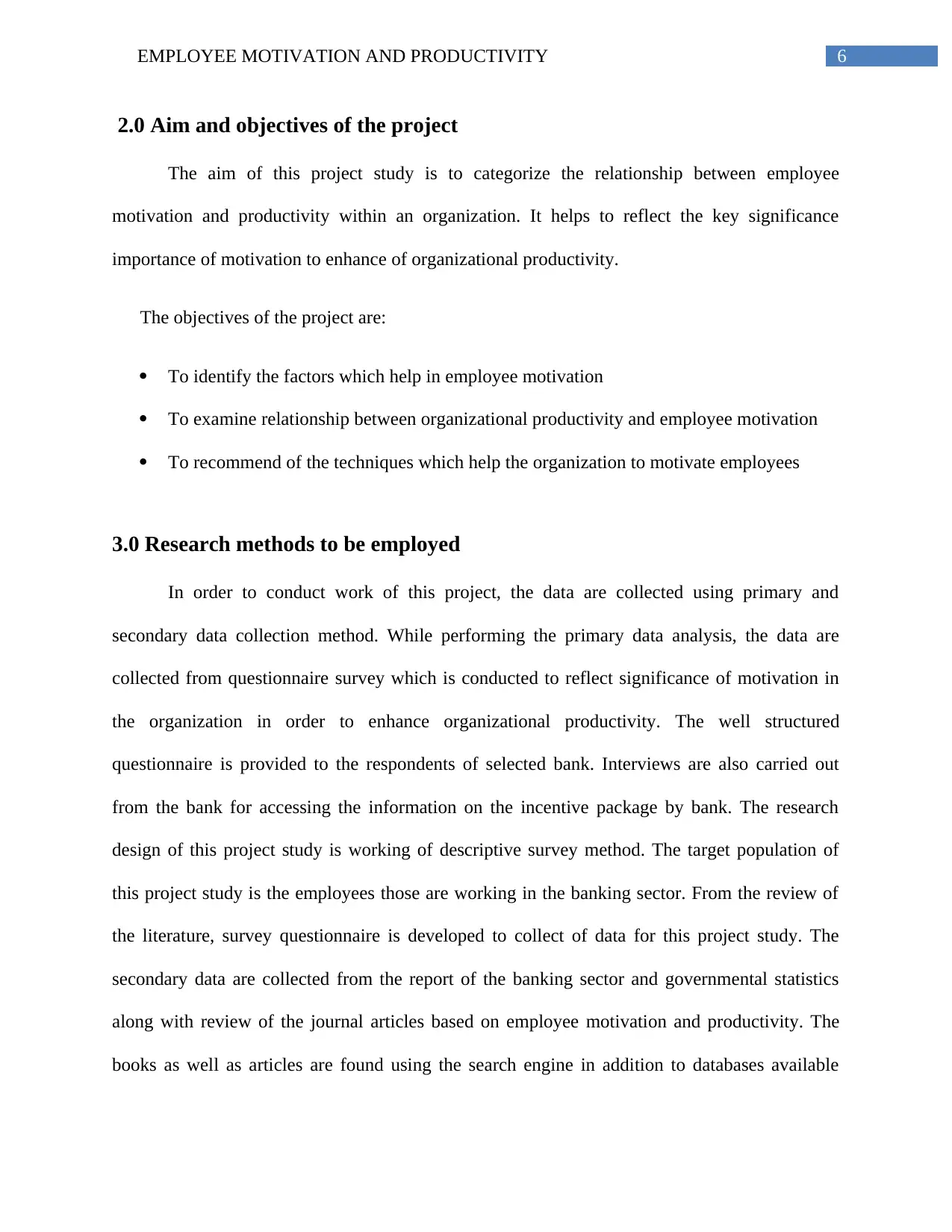
6EMPLOYEE MOTIVATION AND PRODUCTIVITY
2.0 Aim and objectives of the project
The aim of this project study is to categorize the relationship between employee
motivation and productivity within an organization. It helps to reflect the key significance
importance of motivation to enhance of organizational productivity.
The objectives of the project are:
To identify the factors which help in employee motivation
To examine relationship between organizational productivity and employee motivation
To recommend of the techniques which help the organization to motivate employees
3.0 Research methods to be employed
In order to conduct work of this project, the data are collected using primary and
secondary data collection method. While performing the primary data analysis, the data are
collected from questionnaire survey which is conducted to reflect significance of motivation in
the organization in order to enhance organizational productivity. The well structured
questionnaire is provided to the respondents of selected bank. Interviews are also carried out
from the bank for accessing the information on the incentive package by bank. The research
design of this project study is working of descriptive survey method. The target population of
this project study is the employees those are working in the banking sector. From the review of
the literature, survey questionnaire is developed to collect of data for this project study. The
secondary data are collected from the report of the banking sector and governmental statistics
along with review of the journal articles based on employee motivation and productivity. The
books as well as articles are found using the search engine in addition to databases available
2.0 Aim and objectives of the project
The aim of this project study is to categorize the relationship between employee
motivation and productivity within an organization. It helps to reflect the key significance
importance of motivation to enhance of organizational productivity.
The objectives of the project are:
To identify the factors which help in employee motivation
To examine relationship between organizational productivity and employee motivation
To recommend of the techniques which help the organization to motivate employees
3.0 Research methods to be employed
In order to conduct work of this project, the data are collected using primary and
secondary data collection method. While performing the primary data analysis, the data are
collected from questionnaire survey which is conducted to reflect significance of motivation in
the organization in order to enhance organizational productivity. The well structured
questionnaire is provided to the respondents of selected bank. Interviews are also carried out
from the bank for accessing the information on the incentive package by bank. The research
design of this project study is working of descriptive survey method. The target population of
this project study is the employees those are working in the banking sector. From the review of
the literature, survey questionnaire is developed to collect of data for this project study. The
secondary data are collected from the report of the banking sector and governmental statistics
along with review of the journal articles based on employee motivation and productivity. The
books as well as articles are found using the search engine in addition to databases available
Paraphrase This Document
Need a fresh take? Get an instant paraphrase of this document with our AI Paraphraser
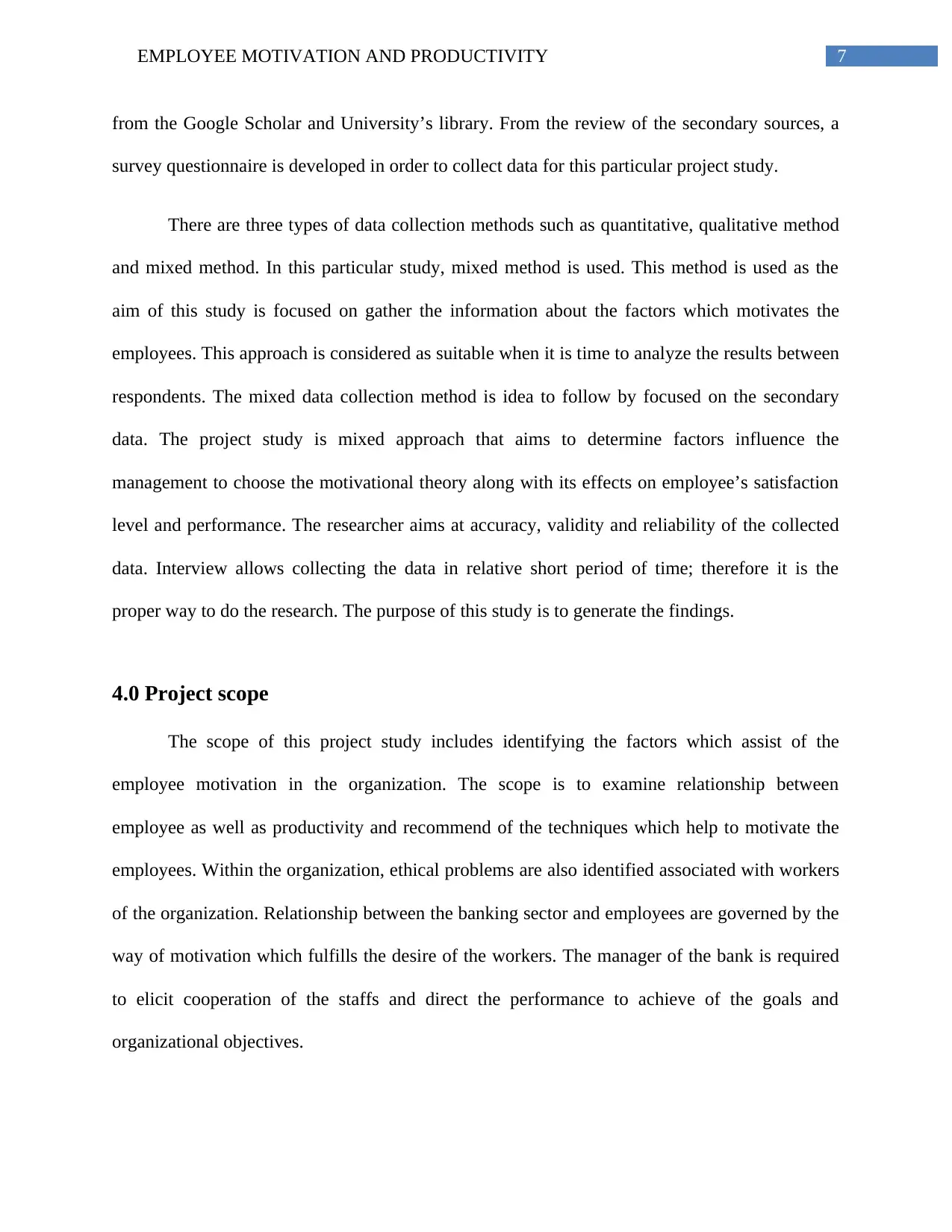
7EMPLOYEE MOTIVATION AND PRODUCTIVITY
from the Google Scholar and University’s library. From the review of the secondary sources, a
survey questionnaire is developed in order to collect data for this particular project study.
There are three types of data collection methods such as quantitative, qualitative method
and mixed method. In this particular study, mixed method is used. This method is used as the
aim of this study is focused on gather the information about the factors which motivates the
employees. This approach is considered as suitable when it is time to analyze the results between
respondents. The mixed data collection method is idea to follow by focused on the secondary
data. The project study is mixed approach that aims to determine factors influence the
management to choose the motivational theory along with its effects on employee’s satisfaction
level and performance. The researcher aims at accuracy, validity and reliability of the collected
data. Interview allows collecting the data in relative short period of time; therefore it is the
proper way to do the research. The purpose of this study is to generate the findings.
4.0 Project scope
The scope of this project study includes identifying the factors which assist of the
employee motivation in the organization. The scope is to examine relationship between
employee as well as productivity and recommend of the techniques which help to motivate the
employees. Within the organization, ethical problems are also identified associated with workers
of the organization. Relationship between the banking sector and employees are governed by the
way of motivation which fulfills the desire of the workers. The manager of the bank is required
to elicit cooperation of the staffs and direct the performance to achieve of the goals and
organizational objectives.
from the Google Scholar and University’s library. From the review of the secondary sources, a
survey questionnaire is developed in order to collect data for this particular project study.
There are three types of data collection methods such as quantitative, qualitative method
and mixed method. In this particular study, mixed method is used. This method is used as the
aim of this study is focused on gather the information about the factors which motivates the
employees. This approach is considered as suitable when it is time to analyze the results between
respondents. The mixed data collection method is idea to follow by focused on the secondary
data. The project study is mixed approach that aims to determine factors influence the
management to choose the motivational theory along with its effects on employee’s satisfaction
level and performance. The researcher aims at accuracy, validity and reliability of the collected
data. Interview allows collecting the data in relative short period of time; therefore it is the
proper way to do the research. The purpose of this study is to generate the findings.
4.0 Project scope
The scope of this project study includes identifying the factors which assist of the
employee motivation in the organization. The scope is to examine relationship between
employee as well as productivity and recommend of the techniques which help to motivate the
employees. Within the organization, ethical problems are also identified associated with workers
of the organization. Relationship between the banking sector and employees are governed by the
way of motivation which fulfills the desire of the workers. The manager of the bank is required
to elicit cooperation of the staffs and direct the performance to achieve of the goals and
organizational objectives.
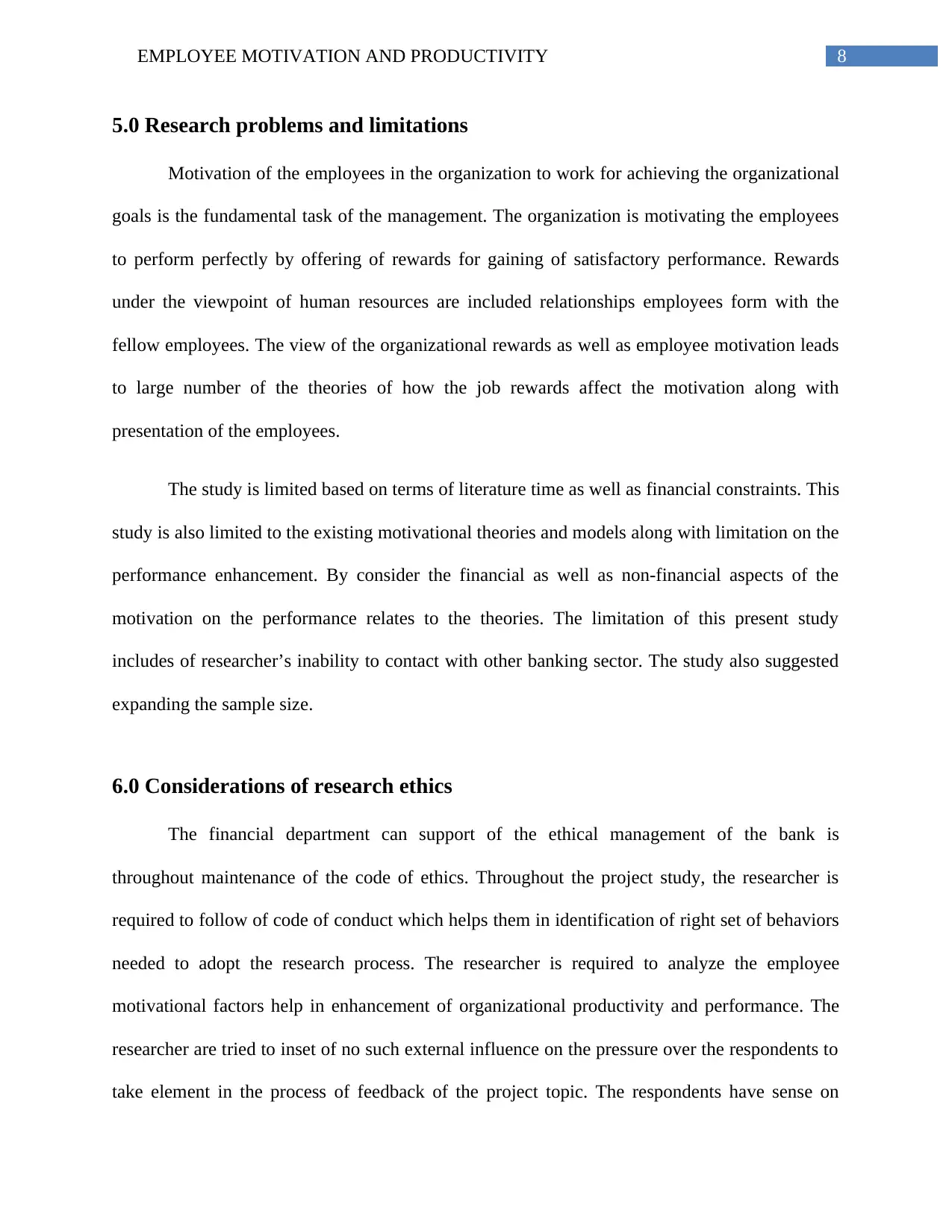
8EMPLOYEE MOTIVATION AND PRODUCTIVITY
5.0 Research problems and limitations
Motivation of the employees in the organization to work for achieving the organizational
goals is the fundamental task of the management. The organization is motivating the employees
to perform perfectly by offering of rewards for gaining of satisfactory performance. Rewards
under the viewpoint of human resources are included relationships employees form with the
fellow employees. The view of the organizational rewards as well as employee motivation leads
to large number of the theories of how the job rewards affect the motivation along with
presentation of the employees.
The study is limited based on terms of literature time as well as financial constraints. This
study is also limited to the existing motivational theories and models along with limitation on the
performance enhancement. By consider the financial as well as non-financial aspects of the
motivation on the performance relates to the theories. The limitation of this present study
includes of researcher’s inability to contact with other banking sector. The study also suggested
expanding the sample size.
6.0 Considerations of research ethics
The financial department can support of the ethical management of the bank is
throughout maintenance of the code of ethics. Throughout the project study, the researcher is
required to follow of code of conduct which helps them in identification of right set of behaviors
needed to adopt the research process. The researcher is required to analyze the employee
motivational factors help in enhancement of organizational productivity and performance. The
researcher are tried to inset of no such external influence on the pressure over the respondents to
take element in the process of feedback of the project topic. The respondents have sense on
5.0 Research problems and limitations
Motivation of the employees in the organization to work for achieving the organizational
goals is the fundamental task of the management. The organization is motivating the employees
to perform perfectly by offering of rewards for gaining of satisfactory performance. Rewards
under the viewpoint of human resources are included relationships employees form with the
fellow employees. The view of the organizational rewards as well as employee motivation leads
to large number of the theories of how the job rewards affect the motivation along with
presentation of the employees.
The study is limited based on terms of literature time as well as financial constraints. This
study is also limited to the existing motivational theories and models along with limitation on the
performance enhancement. By consider the financial as well as non-financial aspects of the
motivation on the performance relates to the theories. The limitation of this present study
includes of researcher’s inability to contact with other banking sector. The study also suggested
expanding the sample size.
6.0 Considerations of research ethics
The financial department can support of the ethical management of the bank is
throughout maintenance of the code of ethics. Throughout the project study, the researcher is
required to follow of code of conduct which helps them in identification of right set of behaviors
needed to adopt the research process. The researcher is required to analyze the employee
motivational factors help in enhancement of organizational productivity and performance. The
researcher are tried to inset of no such external influence on the pressure over the respondents to
take element in the process of feedback of the project topic. The respondents have sense on
⊘ This is a preview!⊘
Do you want full access?
Subscribe today to unlock all pages.

Trusted by 1+ million students worldwide
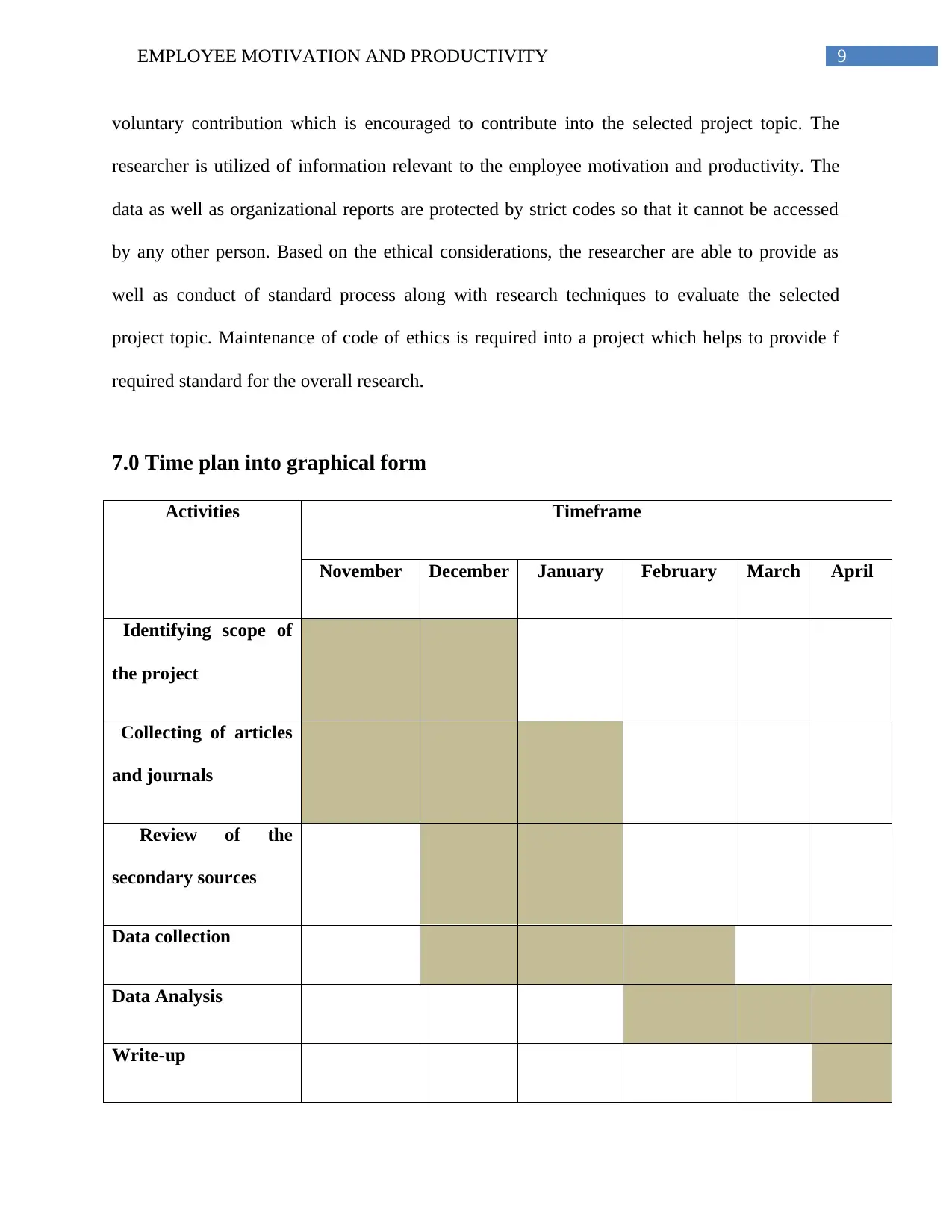
9EMPLOYEE MOTIVATION AND PRODUCTIVITY
voluntary contribution which is encouraged to contribute into the selected project topic. The
researcher is utilized of information relevant to the employee motivation and productivity. The
data as well as organizational reports are protected by strict codes so that it cannot be accessed
by any other person. Based on the ethical considerations, the researcher are able to provide as
well as conduct of standard process along with research techniques to evaluate the selected
project topic. Maintenance of code of ethics is required into a project which helps to provide f
required standard for the overall research.
7.0 Time plan into graphical form
Activities Timeframe
November December January February March April
Identifying scope of
the project
Collecting of articles
and journals
Review of the
secondary sources
Data collection
Data Analysis
Write-up
voluntary contribution which is encouraged to contribute into the selected project topic. The
researcher is utilized of information relevant to the employee motivation and productivity. The
data as well as organizational reports are protected by strict codes so that it cannot be accessed
by any other person. Based on the ethical considerations, the researcher are able to provide as
well as conduct of standard process along with research techniques to evaluate the selected
project topic. Maintenance of code of ethics is required into a project which helps to provide f
required standard for the overall research.
7.0 Time plan into graphical form
Activities Timeframe
November December January February March April
Identifying scope of
the project
Collecting of articles
and journals
Review of the
secondary sources
Data collection
Data Analysis
Write-up
Paraphrase This Document
Need a fresh take? Get an instant paraphrase of this document with our AI Paraphraser
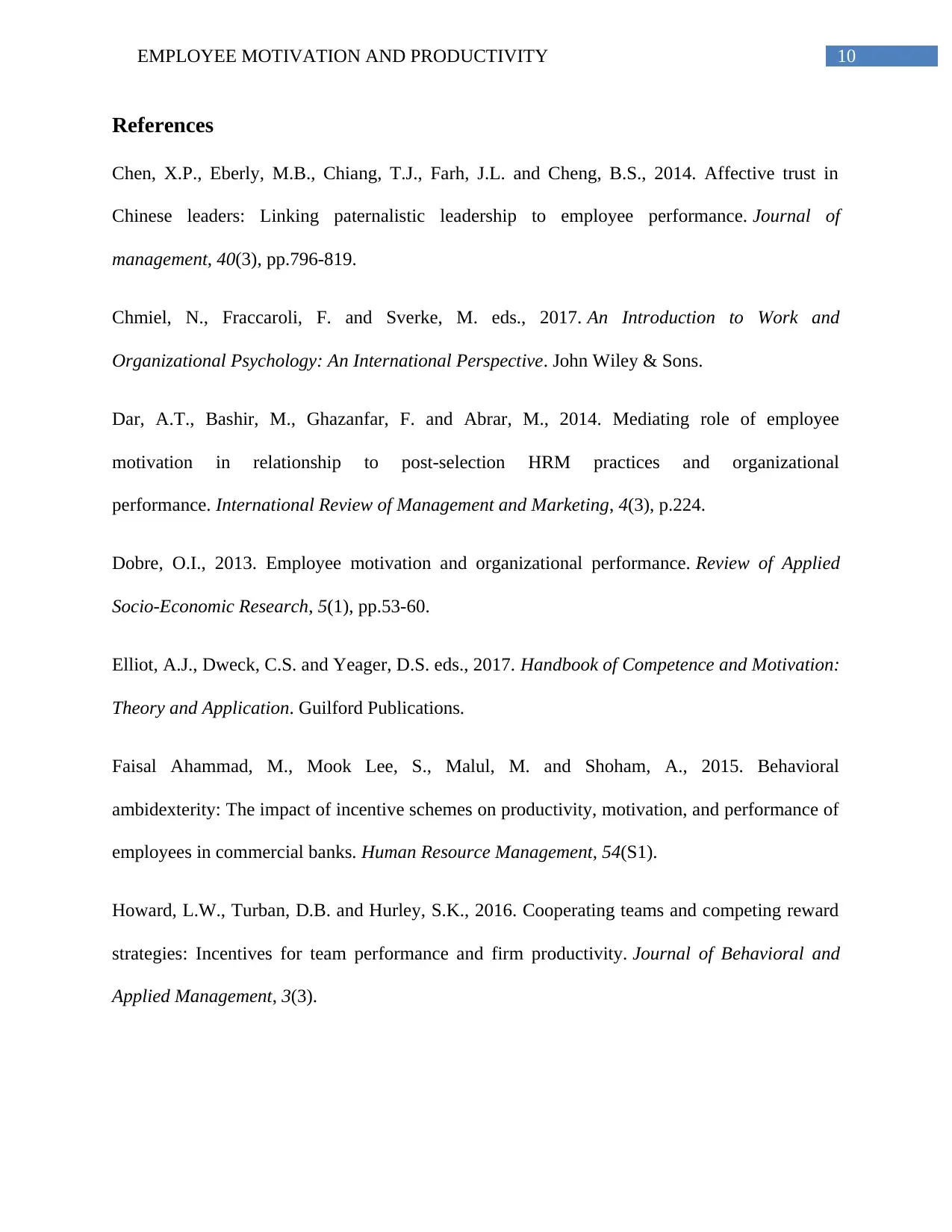
10EMPLOYEE MOTIVATION AND PRODUCTIVITY
References
Chen, X.P., Eberly, M.B., Chiang, T.J., Farh, J.L. and Cheng, B.S., 2014. Affective trust in
Chinese leaders: Linking paternalistic leadership to employee performance. Journal of
management, 40(3), pp.796-819.
Chmiel, N., Fraccaroli, F. and Sverke, M. eds., 2017. An Introduction to Work and
Organizational Psychology: An International Perspective. John Wiley & Sons.
Dar, A.T., Bashir, M., Ghazanfar, F. and Abrar, M., 2014. Mediating role of employee
motivation in relationship to post-selection HRM practices and organizational
performance. International Review of Management and Marketing, 4(3), p.224.
Dobre, O.I., 2013. Employee motivation and organizational performance. Review of Applied
Socio-Economic Research, 5(1), pp.53-60.
Elliot, A.J., Dweck, C.S. and Yeager, D.S. eds., 2017. Handbook of Competence and Motivation:
Theory and Application. Guilford Publications.
Faisal Ahammad, M., Mook Lee, S., Malul, M. and Shoham, A., 2015. Behavioral
ambidexterity: The impact of incentive schemes on productivity, motivation, and performance of
employees in commercial banks. Human Resource Management, 54(S1).
Howard, L.W., Turban, D.B. and Hurley, S.K., 2016. Cooperating teams and competing reward
strategies: Incentives for team performance and firm productivity. Journal of Behavioral and
Applied Management, 3(3).
References
Chen, X.P., Eberly, M.B., Chiang, T.J., Farh, J.L. and Cheng, B.S., 2014. Affective trust in
Chinese leaders: Linking paternalistic leadership to employee performance. Journal of
management, 40(3), pp.796-819.
Chmiel, N., Fraccaroli, F. and Sverke, M. eds., 2017. An Introduction to Work and
Organizational Psychology: An International Perspective. John Wiley & Sons.
Dar, A.T., Bashir, M., Ghazanfar, F. and Abrar, M., 2014. Mediating role of employee
motivation in relationship to post-selection HRM practices and organizational
performance. International Review of Management and Marketing, 4(3), p.224.
Dobre, O.I., 2013. Employee motivation and organizational performance. Review of Applied
Socio-Economic Research, 5(1), pp.53-60.
Elliot, A.J., Dweck, C.S. and Yeager, D.S. eds., 2017. Handbook of Competence and Motivation:
Theory and Application. Guilford Publications.
Faisal Ahammad, M., Mook Lee, S., Malul, M. and Shoham, A., 2015. Behavioral
ambidexterity: The impact of incentive schemes on productivity, motivation, and performance of
employees in commercial banks. Human Resource Management, 54(S1).
Howard, L.W., Turban, D.B. and Hurley, S.K., 2016. Cooperating teams and competing reward
strategies: Incentives for team performance and firm productivity. Journal of Behavioral and
Applied Management, 3(3).
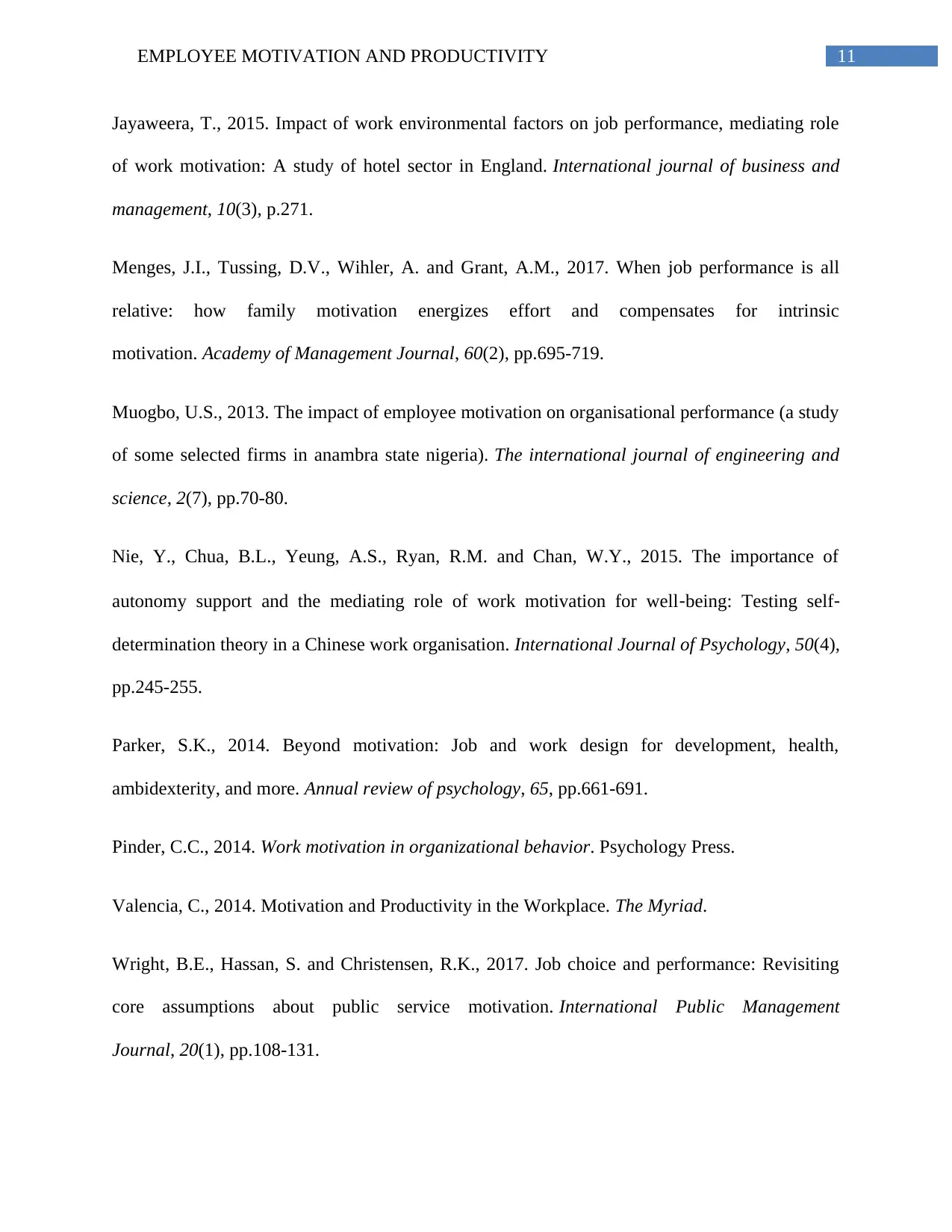
11EMPLOYEE MOTIVATION AND PRODUCTIVITY
Jayaweera, T., 2015. Impact of work environmental factors on job performance, mediating role
of work motivation: A study of hotel sector in England. International journal of business and
management, 10(3), p.271.
Menges, J.I., Tussing, D.V., Wihler, A. and Grant, A.M., 2017. When job performance is all
relative: how family motivation energizes effort and compensates for intrinsic
motivation. Academy of Management Journal, 60(2), pp.695-719.
Muogbo, U.S., 2013. The impact of employee motivation on organisational performance (a study
of some selected firms in anambra state nigeria). The international journal of engineering and
science, 2(7), pp.70-80.
Nie, Y., Chua, B.L., Yeung, A.S., Ryan, R.M. and Chan, W.Y., 2015. The importance of
autonomy support and the mediating role of work motivation for well‐being: Testing self‐
determination theory in a Chinese work organisation. International Journal of Psychology, 50(4),
pp.245-255.
Parker, S.K., 2014. Beyond motivation: Job and work design for development, health,
ambidexterity, and more. Annual review of psychology, 65, pp.661-691.
Pinder, C.C., 2014. Work motivation in organizational behavior. Psychology Press.
Valencia, C., 2014. Motivation and Productivity in the Workplace. The Myriad.
Wright, B.E., Hassan, S. and Christensen, R.K., 2017. Job choice and performance: Revisiting
core assumptions about public service motivation. International Public Management
Journal, 20(1), pp.108-131.
Jayaweera, T., 2015. Impact of work environmental factors on job performance, mediating role
of work motivation: A study of hotel sector in England. International journal of business and
management, 10(3), p.271.
Menges, J.I., Tussing, D.V., Wihler, A. and Grant, A.M., 2017. When job performance is all
relative: how family motivation energizes effort and compensates for intrinsic
motivation. Academy of Management Journal, 60(2), pp.695-719.
Muogbo, U.S., 2013. The impact of employee motivation on organisational performance (a study
of some selected firms in anambra state nigeria). The international journal of engineering and
science, 2(7), pp.70-80.
Nie, Y., Chua, B.L., Yeung, A.S., Ryan, R.M. and Chan, W.Y., 2015. The importance of
autonomy support and the mediating role of work motivation for well‐being: Testing self‐
determination theory in a Chinese work organisation. International Journal of Psychology, 50(4),
pp.245-255.
Parker, S.K., 2014. Beyond motivation: Job and work design for development, health,
ambidexterity, and more. Annual review of psychology, 65, pp.661-691.
Pinder, C.C., 2014. Work motivation in organizational behavior. Psychology Press.
Valencia, C., 2014. Motivation and Productivity in the Workplace. The Myriad.
Wright, B.E., Hassan, S. and Christensen, R.K., 2017. Job choice and performance: Revisiting
core assumptions about public service motivation. International Public Management
Journal, 20(1), pp.108-131.
⊘ This is a preview!⊘
Do you want full access?
Subscribe today to unlock all pages.

Trusted by 1+ million students worldwide
1 out of 13
Related Documents
Your All-in-One AI-Powered Toolkit for Academic Success.
+13062052269
info@desklib.com
Available 24*7 on WhatsApp / Email
![[object Object]](/_next/static/media/star-bottom.7253800d.svg)
Unlock your academic potential
Copyright © 2020–2025 A2Z Services. All Rights Reserved. Developed and managed by ZUCOL.




